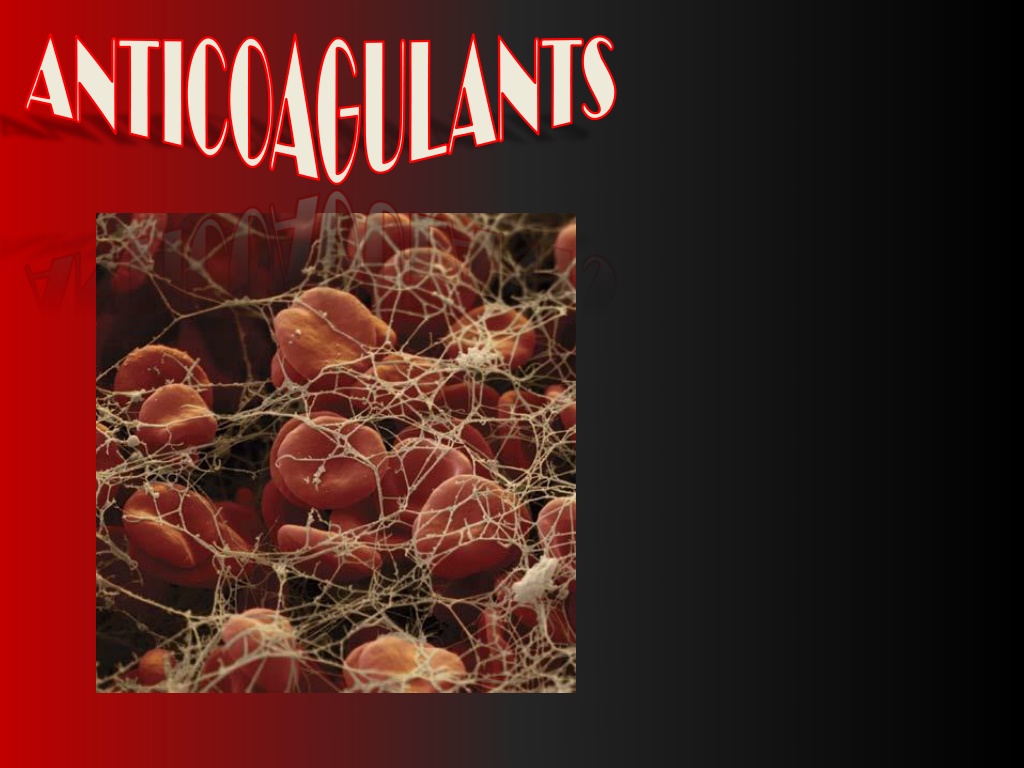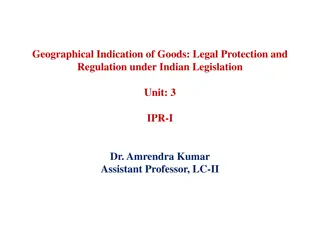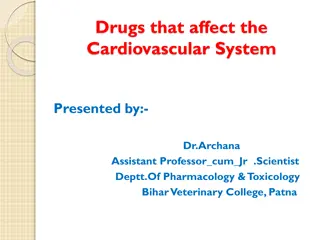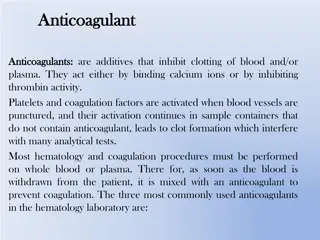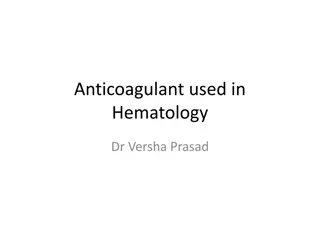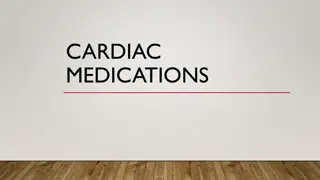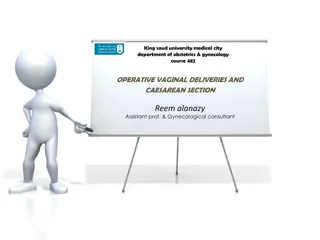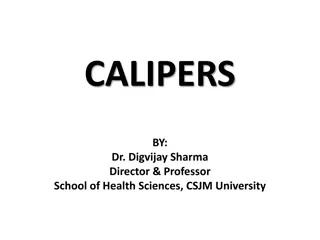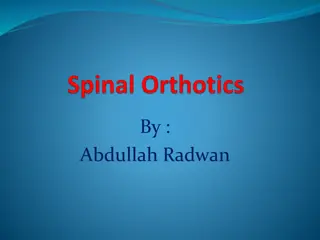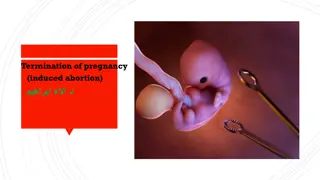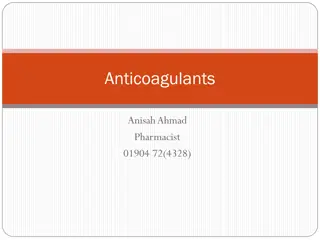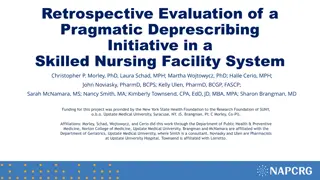Understanding Anticoagulants: Mechanisms, Indications, and Limitations
Anticoagulants play a crucial role in preventing blood clotting and are used in various medical conditions such as myocardial infarction and deep venous thrombosis. They include heparin, warfarin, and antiplatelet agents like aspirin. This article explores the mechanisms of action, indications, and limitations of anticoagulants, highlighting the differences between injectable and oral options. Additionally, it delves into the coagulation pathways and the monitoring of anticoagulant therapy.
Download Presentation

Please find below an Image/Link to download the presentation.
The content on the website is provided AS IS for your information and personal use only. It may not be sold, licensed, or shared on other websites without obtaining consent from the author. Download presentation by click this link. If you encounter any issues during the download, it is possible that the publisher has removed the file from their server.
E N D
Presentation Transcript
ANTICOAGULANTS ANTICOAGULANTS
ANTICOAGULANTS ANTICOAGULANTS ILOs Re-visit the coagulation cascade Classify drugs acting as anticoagulants Elaborate on their mechanism of action, correlating that with methods of monitoring Contrast the limitations & benefits of injectable anticoagulants in clinical settings Emphasis on the limitations of VKAs & on variables altering or modifying their response. Apply such variability in a clinical scenario.
Drugs and coagulation Anti-coagulants are molecules that prevent blood from clotting. They inhibit the chemical process of formation of the fibrin polymer. These include heparin, low molecular weight heparin, coumarins/ warfarin. Molecules that do not allow platelets to aggregrate and thus prevent clotting, especially in the arteries, are called anti-platelet agents e.g aspirin and ticlopidine. Molecules that disintegrate a pre-formed clot are called fibrinolytic agents. A typical example in this category is the enzyme, streptokinase.
Indication of anti-coagulant Anticoagulants are indicated In myocardial infarction, Deep venous thrombosis, peripheral arterial emboli, pulmonary embolism and many other conditions. Anticoagulants are also used in blood transfusions, and dialysis procedures.
Coagulation pathways and anticoagulants
Intrinsic Pathway Clotting: slower / accessed by aPTT Extrinsic Pathway Clotting: is rapid in sec. / accessed by PT Tissue Injury BV Injury Tissue Factor XII XIIa XIa XI VIIIa IX VIIa IXa VII Ca++ Va AT III X Xa X > 1000 times XIII Heparin Prothrombin II Thrombin IIa LMWH Fibrinogen XIIIa Fibrin monomer Vitamin K Antagonists Direct Thrombin Is Fibrin polymer Factor Xa Is
ANTICOAGULANTS ANTICOAGULANTS Parenteral Anticoagulants VENOUS THROMBOSIS Oral Anticoagulants UFH LMWH Vitamin K Antagonists Coumarins; Warfarin > 40 times potency than Dicumarol Factor Xa Is Pentasaccharide X a Direct Thrombin Is 3000-30000 < 8000 > Xa II a Indirect Is Enoxaparin Dalteparin Bivaluridin Lepirudin Fondaparinux R Is IR Is Rivaroxaban Direct Is Argatroban Dabigatran R Is R Is II, VII, IX & X XIIa, XIa, IXa, Xa, IIa Inactivation Of Coagulation Factors Rapid / Variable Decrease Synthesis Slow / Latency / Variable Monitor by aPTT (1.5 - 2.5 times normal [30sec]) Or CT (2-3 times normal [5-7 min) Monitor by PT ( 2 times) INR (2.5) Antidote; Vit. K1 infusion +/ Fresh blood + Needs de novo synthesis Antidote; Protamine Sulphate IV 1mg / 100 units UFH +/ Fresh blood
Anti-thrombin III Anti-thrombin III: It inactivates thrombin and other coagulation factors (IXa, Xa, XIa and XIIa) by forming complex with these factors. Heparin like molecules enhances these interactions. Protein C and S: these are vitamin K dependent proteins that slow the coagulation cascade by inactivating factor Va and VIIIa.
Heparin mechanism of action The anti-coagulant effect of heparin is mediated via anti-thrombin III. Anti-thrombin III inactivate thrombin (essential for clot formation) and other serine proteases (clotting factors) e.g VIIa, IXa and particularly Xa. In the absence of heparin this incativation is slow, heparine acting is a co-factor accelerate the reaction by 1000-fold.
ANTICOAGULANTS ANTICOAGULANTS No predictable anticoagulant effects; inter-patient & intra-patient variability in response to a given dosage in hospital setting, repeated monitoring unfractionated heparin (UFH LIMITATIONS Low bioavailability binds to plasma proteins, endothelium & macrophages Re-thrombosis activates platelets as it does not neutralize fibrin-bound II a No effect on Fibrin-bound IIa
UFH LIMITATIONS ANTICOAGULANTS ANTICOAGULANTS Heparin Induced Thrombocytopenia (HIT); in 4% pts. on heparin, latency 5-10 dys. after 1st exposure or 2-3 dys. after re-exposures V enous > Arterial thombosis Heparin discontinuation No packed platelets More thrombosis No warfarin ppt .venous gangrene Give DTIs PF4= platelet factor 4
LMWH versus UFH LMWH UFH
UF heparin and LMW Heparin The theoretical pharmacologic advantages of LMWH over UFH arise from the preferential binding ratio to factor Xa over thrombin. LMWH (Enoxaparin , Dalteparin) have: less plasma protein binding, less platelet activation and lower risk of re- thrombosis and thrombocytopenia., Good bioavaialibility More predictable response
ANTICOAGULANTS ANTICOAGULANTS Predictability of anticoagulant response i.e. little inter-patient and intra- patient variability in response to a given dosage. without the need for laboratory monitoring Bioavailability; as it hardly binds to plasma proteins, endothelium & macrophages Incidence of thrombocytopenia; as it seldom sensitive to PF4 Incidence of bleeding tendency; Much better tolerability; given sub. cut. frequency of administration due to longer duration of action need for regular monitoring Outside hospital settings LMWH BENIFITS effect AT III & platelet interactions
ANTICOAGULANTS ANTICOAGULANTS Non-Functioning Coagulation Factors VKAs Biologically Functioning Coagulation Factors Carboxylase Warfarin Precursors of factors II, VII, IX & X require carboxylation of their glutamic a. residues to allow them to bind to phospholipid surfaces. This is provided by Vit. K as it changes from its oxidized to its reduced form. Instantaneously , the reduced Vit K has to recycle back to oxidized form by Vit K epoxide reductase. This enzyme is blocked by VKAs losing the coagulation factors the ability to function.
Mechanism of Action of Warfarin Inhibits synthesis of Vitamin K- dependent coagulation factors II, VII, IX, & X as well as anticoagulant proteins C & S Does not have an effect on already- synthesized coagulation factors; therefore, the therapeutic effects are not seen until these factors are depleted 3-4 days until effect is seen
ANTICOAGULANTS ANTICOAGULANTS Wide variation in drug response VKAs LIMITATIONS . Has narrow therapeutic window, So any change in that level can be hazardous. Slow onset of action, so not in given in emergency conditions Polymorphisms in CYT P450 isoforms that metabolizes warfarin adds to its non predictable response liability to toxicities or under use. Numerous food- & drug-drug interactions liability to toxicities or under use. Contraindicated in pregnancy give heparin or LMWH instead
FACTORS ALTERING RESPONSE TO VKAs 1. Vitamin K deficiency; a- Inadequate diet; malnutrition, dieting, decreased GI absorption . 2. Impaired synthesis of clotting factors; a. In hepatocellular disorders; ( hepatitis;infective or chronic alcoholism ... etc.) 3. Increased catabolism of clotting factors; In hypermetabolic states; as in fever, thyrotoxicosis 1. Decreased plasma protein binding; elimination of free drug & shortening of its t1/2. as pts with nephrotic syndrome (proteinuria) 2. Decreased catabolism of clotting factors; Hypothyroidism 3. Hereditary resistance to oral anticoagulants
DRUGS MODULATING RESPONSE TO VKAs 1. Inhibition of Vit. K synthesis by intestinal flora; oral antibiotics 2. Inhibition of Vit K absorption; liquid paraffin 3. Decrease in drug metabolism by microsomal enzyme inhibitors; chloramphenicol, & cimetidine 4. Displacment of the drug from protein binding sites; phenylbutazone & salicylates 5. Co-administration of drugs that increase bleeding tendency by; inhibiting platelet function; NSAIDs inhibiting coagulation factors; heparin 1. Inhibition of drug absorption from GIT; cholystyramine, colestipol 2. Increase in synthesis of clotting factors; Vit K, oral contraceptives 3. Increase in drug metabolism by microsomal enzyme inducers; Carbamazepine; barbiturates, rifampicin
An old, peptic ulcer patient, sustained on cimetidine, has been bed ridden since a month following a major orthopedic surgery for pelvic fracture. The last week he began to complain of pain, tenderness, warmth & swelling of his left leg. He was diagnosed as deep vein thrombosis. His treating physician put him first on heparin that was replaced after three days by VKAs. Today he began to show bleeding of gums. What is the expected explanation of his finding? Will the treating physician 1st of all, consider giving an antidote to stop bleeding ( if so then state) or will he probably ask for lab investigation ( if so then state)? Once lab findings are there, is the physician expected first to withdraw or to adjust the existing therapy? http://t0.gstatic.com/images?q=tbn:6iDMZk8u2hiycM:
A young rheumatic artheritic patient has underwent valve replacement and is sustained on warfarin therapy for the last three years. When she married, last summer, she did not want to get pregnant, so she has taken since then, oral contraceptive pills. Her regular lab monitoring today showed a decrease in INR this time. What is the expected explanation of her lab result? What will the treating physician consider doing? -Giving heparin on top -Adjusting warfarin dose - Stopping the OC - Stopping warfarin Blood Clot
A 53 years old patient had an aortic valve replacement since 5 years and he is sustained on warfarin. A week ago, he developed low grade fever, diarrhea and was diagnosed as having typhoid. He was given rehydration fluid and a course of chloramphenicol. Today he is complaining from haematuria. Which one of the following best explains the haematuria? - Inhibition of Vit K synthesis by chloramphenicol - Displacement of warfarin from protein binding site by rehydration - Decrease in warfarin metabolism induced by chloramphenicol - Inhibition of Vit K absorption caused by the diarrhea Which is the right decision to do in such a case? - Give a urinary antiseptic for fear of infection - Stop administering the regular intake of warfarin - Adjust the dose of warfarin after monitoring the situation. - Stop the course of chloramphenicol intended for typhoid therapy
ANTICOAGULANTS ANTICOAGULANTS
